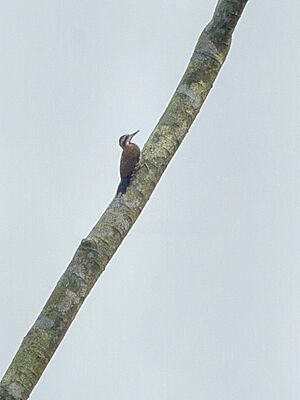Fire-bellied woodpecker facts for kids
Quick facts for kids Fire-bellied woodpecker |
|
|---|---|
 |
|
| Conservation status | |
| Scientific classification | |
| Genus: |
Chloropicus
|
| Species: |
pyrrhogaster
|
| Synonyms | |
|
Thripias pyrrhogaster |
|
The fire-bellied woodpecker (Chloropicus pyrrhogaster) is a colorful bird. It belongs to the Picidae family, which includes all woodpeckers. You can find this bird in many countries in West Africa. These include Benin, Ivory Coast, Ghana, Guinea, Liberia, Mali, Nigeria, Sierra Leone, Togo, and western Cameroon. Scientists say it is a common bird. Its conservation status is "least concern". This means it is not currently in danger of disappearing.
Contents
What Does the Fire-bellied Woodpecker Look Like?
The fire-bellied woodpecker is a striking bird. Its upper body is olive or bronze. It has some light stripes. Its wings are brown with a few pale bars. The upper part of its tail is blackish. The lower back and upper tail feathers are bright crimson.
Its head and throat are white. A bold blackish stripe runs from its beak to its chest. Another stripe goes from behind its eye to its ear. Its chest is creamy white. Dark V-shaped marks appear on its sides. The center of its belly is bright scarlet. This red color goes all the way to its vent.
Its long, sharp beak and legs are grey. Male and female woodpeckers look a little different. The male has a red crown and the back of his neck is red. The female has black in these areas. Her tail is longer, and her beak is shorter than the male's. The red on her belly is also less bright. Young woodpeckers are duller and browner. Both young males and females have some red on their crowns.
Where Does the Fire-bellied Woodpecker Live?
The fire-bellied woodpecker lives in tropical West Africa. Its home stretches from Upper Guinea and Sierra Leone. It goes east to southern Nigeria and western Cameroon. You can find it in lowlands and hills.
It likes to live in clearings and edges of rainforests. It also lives in forests along rivers. You might see it in scattered woodlands or areas where trees have been cut. It can also be found in wooded grasslands and bushy areas. There are usually some large dead trees nearby. This bird does not migrate, meaning it stays in the same area all year.
How Does the Fire-bellied Woodpecker Live?
This woodpecker is usually seen in pairs. Sometimes you might see small family groups. It also sometimes joins other birds that eat insects. It searches for insects to eat. Its favorite food is beetle larvae. It mostly looks for food high up in the trees. It also searches on dead standing trees. Sometimes it will go down to fallen trees.
Both male and female woodpeckers make drumming sounds. They do this in the dry season. Their drumming is a series of short, fast bursts. They can hit the tree 14 to 38 times per second!
Is the Fire-bellied Woodpecker in Danger?
The fire-bellied woodpecker has a very large home range. It is a common bird. Its population seems to be growing. This is because a few large trees are often left behind when forests are cleared. These trees provide good homes for the woodpeckers. The International Union for Conservation of Nature says its conservation status is "least concern". This means it is not currently at risk of extinction.


